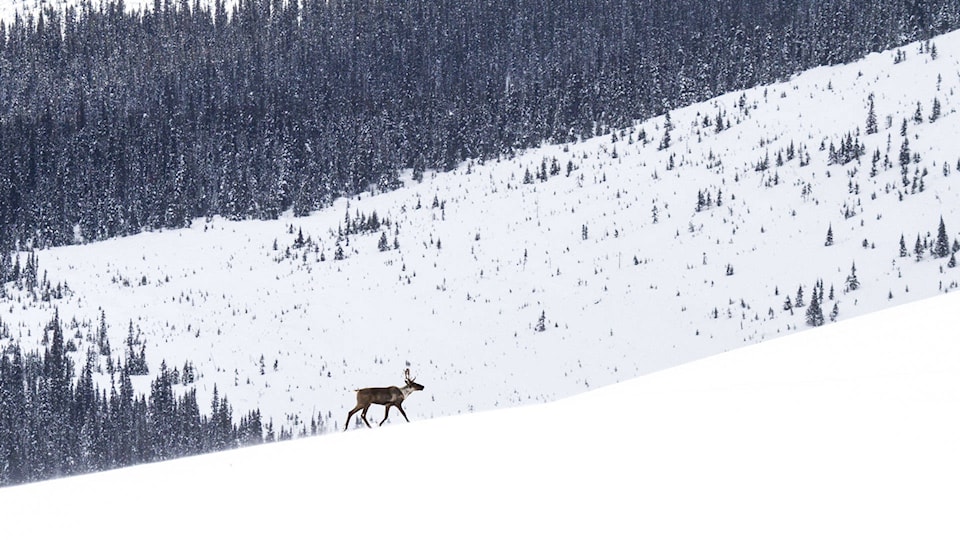A recent count of the South Selkirk caribou herd has revealed that there are only three females left, and environmentalists are now scrambling to consider a response.
“It’s devastating that we’ve nearly lost the South Selkirk caribou herd,” John Bergenske, Wildsight’s Conservation Director, said on Thursday, “but what’s worse is that unless we take immediate action to protect all critical mountain caribou habitat, the South Purcells and other southern herds won’t be far behind.”
Berganske said that Wildsight is mourning the loss of most of the herd in the last year. The already tiny population’s drop was discovered in an aerial census this spring.
“We’ve known for decades that logging, road-building and uncontrolled recreation in mountain caribou habitat are slowly killing off our caribou herds,” Eddie Petryshen, Wildsight’s Conservation Coordinator, said in a press release. “Protecting intact habitat in our mountain rainforest ecosystems is the only way to give our southern caribou herds a chance to survive, but our federal and provincial governments have been dragging their feet for years, ignoring the ongoing destruction of mountain caribou habitat.”
Fewer than 250 mountain caribou remain in the Kootenay and Columbia area, mostly found in herds around Revelstoke, and only thirteen caribou were found in the South Purcells herd census last year.
“The federal government has mapped the mountain caribou habitat that is necessary for the species’ survival, but they have only protected portions of it,” Bergenske said. “This tragic loss of all but three caribou in the South Selkirk herd has to be a wake-up call for Environment Minister Catherine McKenna to act on her responsibility under the Endangered Species Act to protect all critical habitat right now. This is an emergency and our mountain caribou can’t wait any longer for planning without action.”
Relying on a winter diet of lichens that grow on old-growth trees, the southern mountain caribou have faced declining food sources as the result of logging, and the animals are also extremely sensitive to disturbance from motorized recreation. The packing of winter trails by skiers and snowshoe enthusiasts has also contributed to making them more susceptible to predators, Wildsight reps say.
With “nowhere to run” Berganske, the herd‘s decline has continued over the past decade despite the efforts of BC’s Mountain Caribou Recovery Implementation Plan.
“Not only do we need to protect all critical caribou habitat now, we need to restore degraded and fragmented habitat,” says Bergenske, “and that means the province and the federal government need to put real resources into habitat restoration immediately.”
“Today, the South Purcells herd is facing not just loss of their habitat, but serious threats from ever-increasing recreation, including a new proposal for heliskiing and helibiking in their habitat,” says Petryshen. “If we don’t take emergency measures now, it may be too late for the South Purcells herd.”
Trish Drinkle says that the story is complex and that too often conservation efforts are influenced by emotion when they should be driven by science.
Drinkle, an avid snowmobiler and dirt biker, has also been working with the Recovery Implementation group.
“What is most frustrating is when politics gets in the way of conservation,” she said on Monday. “What feels good to people in urban areas often does not reflect the realities of the backcountry. More closures will make no difference. 80 percent of the caribou habitat has already been secured.”
Important to note, she said, is that caribou herds have also been declining in national parks, where they are protected from most of the concerns listed by Wildsight.
“I wanted the caribou to be protected from vehicles on the highway, and to keep them from being habituated in the Kootenay Pass area,” she said. “Predation management (a wolf kill, for example) was necessary, but it was too little too late.”
Drinkle said that history indicates that human activity is not the only threat to the mountain caribou.
In 1918, she said, there was a hunting closure to protect the South Selkirk herd.
“Climate change as noted back then as a factor,” she said. “This is no longer a viable environment and habitat—we need to focus on herds where the habitat is viable. If the caribou here struggled in 1918, why would it be different now?”
Conservation “is tough”, she said. “Conservation is science, not emotion. The majority of the population is in urban areas and they see conservation as a feel-good issue. ‘Don’t hunt the grizzly bear, but keep the caribou alive’ are emotional arguments.”
What to do now? Drinkle suggest translocating the three remaining caribou cows to a viable herd.
“Perhaps we should introduce a captive breeding plan” to build herd populations where they can thrive, and not just where people want them to be, she added.
“More closures are not the solution. We have so much land available,” she said. “Certainly closures are necessary in certain situations, but they are only one part of a complex problem.”
